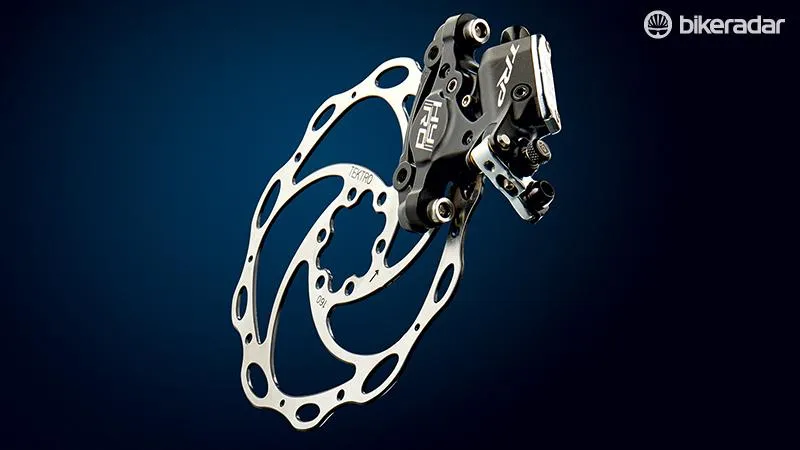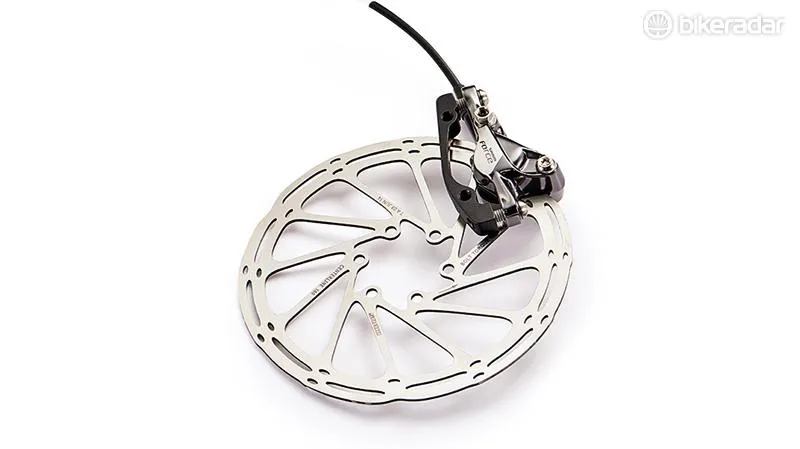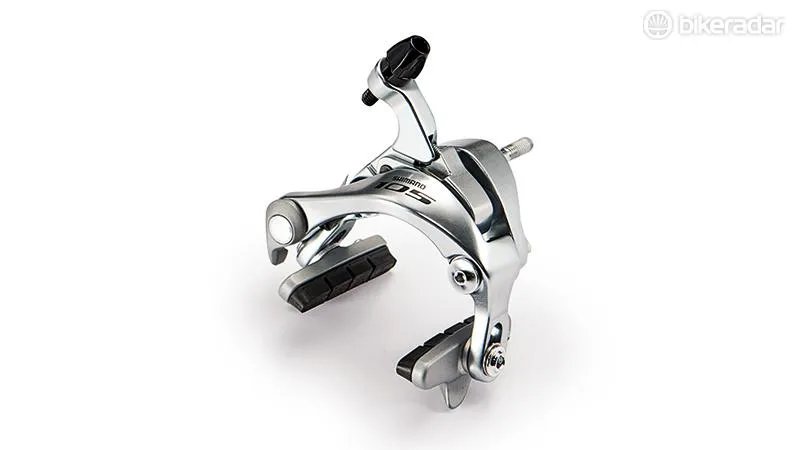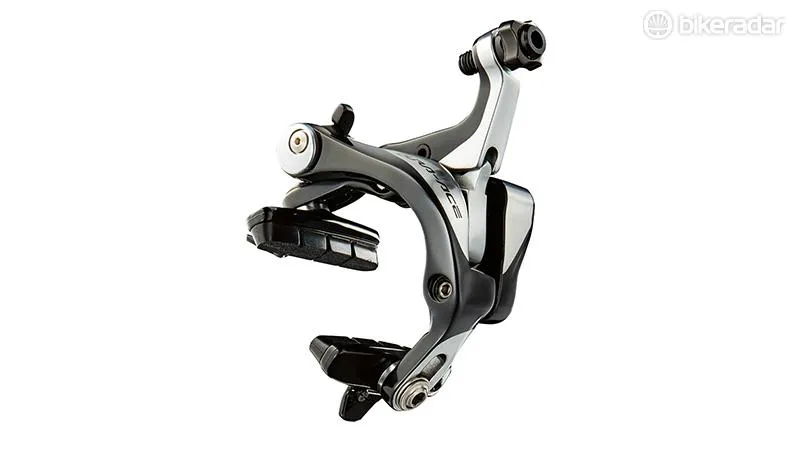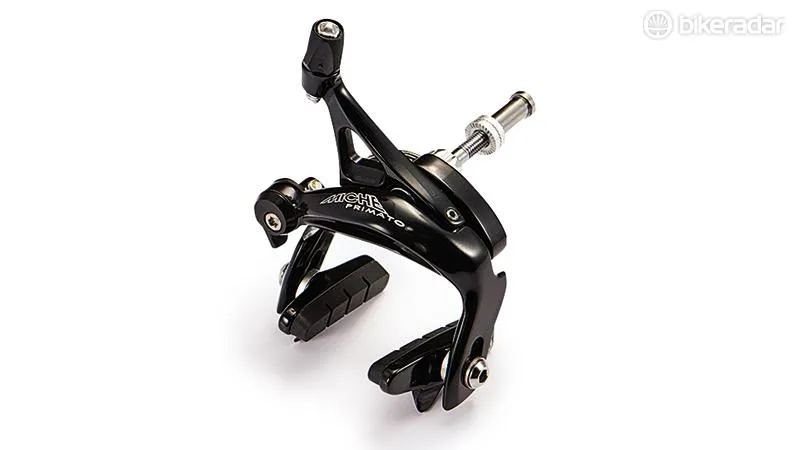There have never been so many ways to stop your road bike. This is great in terms of options, but a nightmare in terms of choosing. Luckily our ultra-experienced test team are here to sort out which, exactly, are the right stoppers for you.
If you’re upgrading your brakes on your current bike, your frame and fork make the first choice for you. Most conventional bikes use side-pull rim brakes with a long central fixing bolt in the fork crown up front, and a short bolt fixing in the bridge between the rear seatstays in the rear. You’ll also need to work out whether you need a long-drop brake to fit a bike with ample mudguard/tyre clearance, or a standard (stiffer and lighter) close-clearance brake. Some brakes also have a limited span and might not work with the widest rims.Once fit is sorted, the choice is between conventional side-pull brakes, which are lighter but generally less powerful, and dual-pivot brakes, which are heavier but more powerful. Paying more should get you a lighter brake without sacrificing stiffness and accuracy, and features such as better bearings for improved feel and longevity.
Some of the latest aero style bikes use direct mount brakes that fit directly onto posts on the fork legs and chainstays. Some of these use conventional side-pull brake cable routing but others use a centre-pull stirrup or even a transverse cable scissor design to sync with the layout of the bike, which generally limits upgrade options. Some aero bikes use their own proprietary brakes that sync directly with the frame as a fixed package.
Finally, there are more and more bikes appearing that have brackets for disc brakes on suitably reinforced forks and rear stays. The cheapest disc brakes are controlled by a conventional lever and brake cable which maximises compatibility and simplifies maintenance. Lever feel and power are generally softer, though, and you have to adjust for pad wear manually. Hydraulic (or semi-hydraulic) systems are more expensive but brake feel and power is excellent and they self-adjust for pad wear.
All weights and prices given in our reviews are for a single front caliper (including the lever on full hydraulic systems), and the disc brakes include the price and weight of the disc rotor.
Key brake components
- Levers: All the cable brakes here are designed to work with the cable pull of an STI shifter. We tested every cable brake with Shimano Ultegra 6800 levers. Hydraulic brakes work with a dedicated lever: Shimano uses mineral oil, and SRAM uses synthetic DOT brake fluid, so there’s no mix and matching.
- Control line: Most brakes come with an outer cable that uses a coiled metal wrap under the skin. The cable compression when you brake can make disc brakes’ longer cable runs feel mushy. That’s why Tektro produces a slightly spiral inline cable outer that doesn’t compress when squeezed between lever and brake.
- Mounts: We tested the rim brakes in the centre bolt format, but a lot of frames are now using ‘direct mount’ brakes. Disc brakes use the same slotted caliper design. This bolts directly into threaded sockets on the fork leg and frame, or uses a spacer/bracket between brake and bike if you run 160mm rotors or an IS mount.
- Discs: The bigger the disc/rotor, the more leverage it exerts, and you’ll get around 20 percent more power from a 160mm rotor than a 140mm one. Bigger rotors also dissipate heat better. But more power means more weight, and more chance of your tyres sliding rather than gripping if you’re not careful.
- Pads: Whether you’re using disc or rim brakes, the type of pads you use can be crucial. Performance – in terms of power, noise, wear life and modulation – can vary significantly between different pad compounds. And pads for carbon wheels use an entirely different compound to pads for alloy wheels.
- Braking Surface: Whether your braking surface is a wheel rim or a rotor, keeping it clean is crucial to ensuring your brakes work to their full potential. Check for gouges and dents, wipe off grime, make sure the rotors are perfectly straight and never contaminate them when you’re lubing your chain.
Best disc brakes
Shimano R785 – best disc brakes on test

Shimano's R785 discs are heavier than SRAM but deliver unbeatable control and reliability for the price
- Price: £300 / US$349 / AU$598
- Weight: 528g
- Rotor: 160mm
- Hydraulic
Whatever 11-speed shifting you combine it with, Shimano’s hydraulic disc is the current state-of-the-stopping art. We’ve tested the Di2 electronic shifting version here, but the mechanical version (R658) is identical in terms of the brake – and cheaper.
Impressively, there’s no obvious change in external dimensions or even lever pull distance compared with conventional STIs. The super-light, ultra-consistent, any-weather control is definitely hydraulic, though: single-finger power is ample and the finned Ice-Tech pads and bi-metal sandwich frilled ‘Freeza’ rotors dissipate heat very effectively. Currently Shimano only offers its Freeza rotors in a Centerlock splined mount; those with six-bolt disc hubs will need to look to less fancy rotors.
They are heavier than the SRAM competition but they are significantly cheaper even if you get your local shop to fit and bleed them rather than plumbing the separate levers, hose and calipers yourself.
For brake pad options, you can choose the organic (which comes standard) for softer initial bite and better modulation, or metallic for foul weather, especially if you're doing cyclocross where grit could get into the brakes.
Verdict: Taking overall performance, cost and reliability into account, you can't do better than the R785s
www.shimano.com / Buy from Merlin Cycles
TRP Hy/Rd

TRP's Hy/Rd brakes have a unique and effective hybrid design that delivers hydraulic control from a cable lever
- Price: £110 / US$150 / AU$189
- Weight: 324g
- Rotor: 160mm/140mm
- Semi-hydraulic
The idea behind TRP's Hy/Rd, which we first got our hands on a couple of years back, is simple. Fully hydraulic systems demand new, very expensive hydraulic brake/shift levers but cable driven discs are often spongey in feel and need manual pad wear compensation. This hybrid uses a hydraulic brake controlled with a conventional cable pull so you can still get hydraulic benefits with your existing brake/shift levers.
Despite initial reservations about cable stretch leading to soft braking feel lever feel and modulation are noticeably better than even TRP’s own stirrup operated Spyre brake (see below). While there is some softness with conventional cables on the rear it’s actually pretty close to a full hydraulic system in terms of fine control and feedback when used with compressionless brake outer from Tektro or another brand. Pad wear is compensated for automatically by the hydraulic reservoir and the barrel style cable tension adjuster plus a lockable actuator arm make set up very easy.
Our initial reservations about putting the hydraulic fluid reservoir on top of the potentially scalding hot brake caliper have proved unfounded too. Our colleagues in Colorado have dragged this brake down 20 mile plus descents without boiling it though and it’s even survived deliberately abusive tandem testing in the UK. That leaves relatively high weight as the only potential gripe but pads (it takes Hope style aftermarket pieces) are widely available and price is reasonable too.
Verdict: The ultimate control upgrade for disc-compatible cable brake bikes
www.trpbrakes.com / Buy from Chain Reaction Cycles
TRP Spyre – best value disc brakes
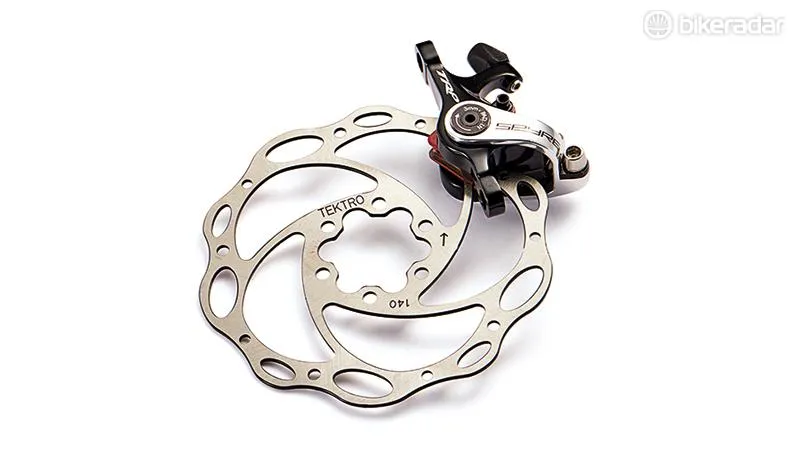
We reckon TRP's Spyre mechanical disc brakes are the best value out there
- Price: £70 / US$90 / AU$130
- Weight: 267g
- Rotor: 160mm
- Cable-operated/mechanical
With the Spyre, TRP has rewritten the design book for cable-operated disc brakes and reset the performance benchmarks in the process. Using a stirrup that moves both pads simultaneously is a simple idea superbly executed.
Because both pads move, the pad gap can be larger for quieter free-running without changing the contact point. And as the rotor is being squeezed from both sides rather than pushed from moving pad onto static one, control is more consistent, noise is reduced and they feel more powerful. The pads are a widely available standard, too, and they’re among the lightest cable discs available.
Verdict: TRP has delivered amazing performance through cable levers with the Spyre
www.trpbrakes.com / Buy from Merlin Cycles
SRAM Force 22 Hydro R Disc
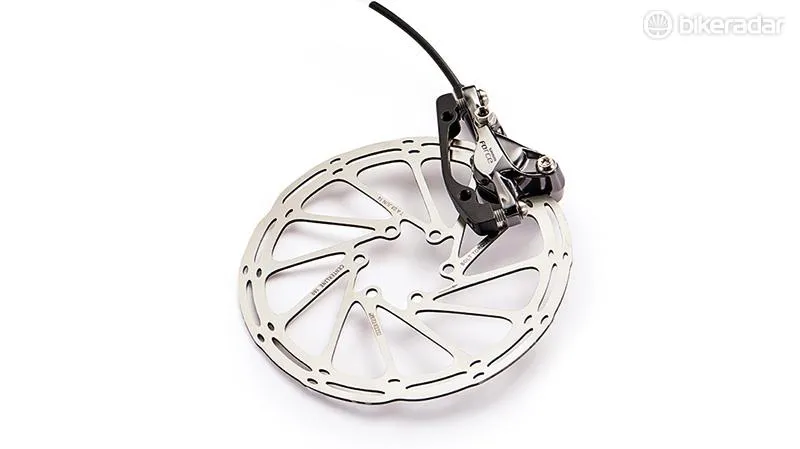
They're pricey, but SRAM's Force 22 Hydro R Disc offer refined power and great grip in the hoods
- Price: £385 / US$419 / AU$720
- Weight: 481g
- Rotor: 160mm
- Hydraulic
SRAM’s hydraulic brake levers have a distinctive love/hate aesthetic, reminiscent of the famous Easter Island head statues. The brakes' shape only delivers positives in terms of performance though, with the tall lever body giving a safe and secure position that lets you brake or corner hard from the hoods without worrying about slipping off the top. It's no surprise SRAM’s 11-speed CX1 cyclocross group uses the same lever/brakes, just without the shifting guts in the left hand side. The design also puts the reservoir at the top of the body so any air bubbles are kept well away from the master cylinder. The various bike mechanics we talked too all praised SRAM for easier bleeding and servicing than Shimano.
While original SRAM Red and Force discs had to go through a full recall last year, we’ve had no low temperature or extended descent issues with current generation brakes. Modulation/control is excellent, though it’s worth noting that the contact point and full power lever position is much closer to the bars than Shimano, which some testers don’t like.
If you compare SRAM with SRAM, the key thing to note is that body, internals and braking performance are the same as Red. Force swaps carbon shift levers for alloy and titanium fixtures for stainless steel, adding just 9g but saving significant cash to make the Force brakes a smarter buy if you’re running SRAM.
Verdict: Expensive but secure hood grip and sweetly controlled, easy to maintain all-weather power
www.sram.com / Buy from Chain Reaction Cycles
Best caliper brakes
SRAM Red 22 Hydro R – best caliper brakes on test
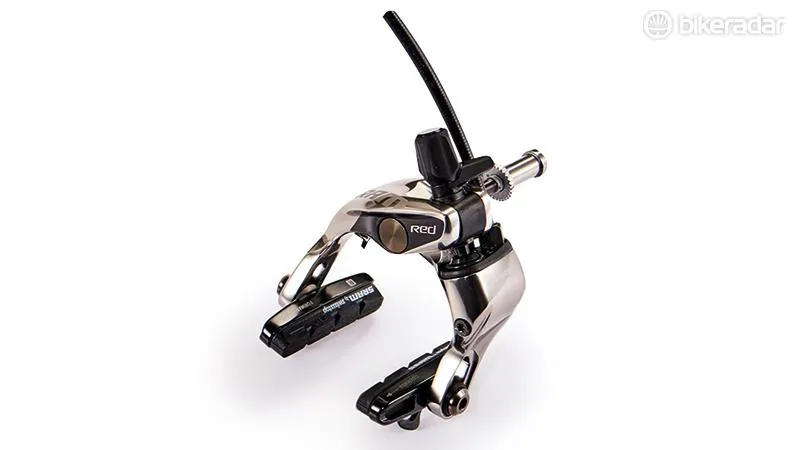
If money's no object, SRAM's Red 22 Hydro R are in our opinion the best rim brakes you can buy
- Price: £386 / US$425 / AU$750
- Weight: 400g
- Max rim width: 30mm
- Max rim drop: 50mm
SRAM’s HydroRs are the best rim brakes we’ve used. The lever is the same tall ‘Easter Island’ design as the Red/Force disc lever, which divides aesthetic opinion but provides a secure handhold and easy bleeding if you need to dismantle the brakes for internal routing. The difference here is that rather than a disc brake caliper on the other end of the hose you get a single pivot rim brake driven by a hydraulic master cylinder. The direct hydraulic connection gives significantly more precise and richly detailed feedback than even the best cable brakes. Because the hydraulic lines can be curved much more tightly without compromising control and feel, they’re particularly well suited to any frame with awkward cable/hose routing too.
The hydraulics also convert relatively light lever pressure into crushing power. The increase in power takes some time to get used to but after a few skids we had ultra subtle, last second, single finger braking nailed and Swiss Stop pads give consistent all weather stopping. There’s a tool-free quick release and pad span/contact point adjust with enough gap for the widest rims if you want.
At 142g for the caliper there’s only a 15g weight penalty over cable operated Red rim brakes and they're lighter than Shimano Dura-Ace and Campagnolo Record brakes. They're also cheaper than Red Disc, plus Force 22 and Rival 22 versions offer slightly heavier but otherwise similarly excellent performance at a a better value price.
Verdict: SRAM’s outstanding hydraulic brakes are the ultimate in rim-based stopping control
www.sram.com / Buy from Wiggle
Shimano 105 – best value caliper brakes

Shimano 105 brakes have benefited from some quality trickle down via their Dura-Ace and Ultegra siblings
- Price: £35 / US$52 / AU$69
- Weight: 191g
- Max rim width: 30mm
- Max rim drop: 50mm
Shimano’s latest 105 groupset not only got an 11-speed upgrade, it also inherited the excellent SLR EV brake architecture from Dura-Ace and Ultegra, although the pads aren’t quite as grippy and there’s some notchiness in the action compared with Ultegra. The calipers' raised arch provides plenty of room to accommodate rubber up to 28mm.
Widening the pivot placement boosts power by a claimed 10 percent over a conventional dual pivot, and control is better than anything else at this price. The penalty is weight, but as you’ll be stopping later with more confidence, we reckon that outweighs the extra 50g or so per pair over a conventional dual pivot.
Changing brake pads is a simple task, as is adjusting the brake on the fly.
Verdict: Unbeatable value for a very modest performance penalty compared with its more expensive siblings
www.shimano.com / Buy from Wiggle
Shimano Dura-Ace 9000 – best mechanical calipers on test
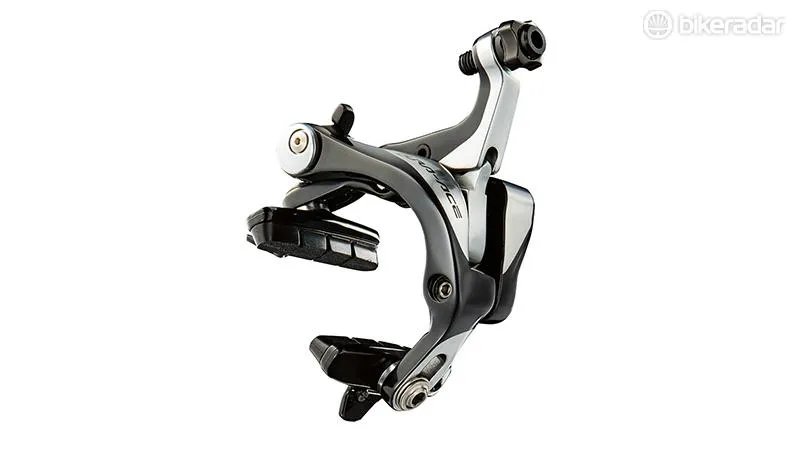
Dual-pivot Dura-Ace 9000s are pretty much unbeatable as far as mechanical rim brakes go
- Price: £120 / US$199 / AU$209
- Weight: 150g
- Max rim width: 30mm
- Max rim drop: 52mm
Dura-Ace 9000 introduced Shimano’s SLR EV dual-pivot design, which effectively creates a central mount-compatible direct mount brake. It significantly boosts leverage, making these brakes more powerful – albeit slightly heavier – than standard dual pivots. These calipers gives disc brakes a serious run for the money.
Stiff architecture, super-smooth pivots and a roller-guided upper arm mean fine control is outstanding. The indexed cable clamp also allows fine clearance adjustment on the fly.
It’s worth noting that while they physically open wider, Shimano lists 25mm tyres and 28mm rims as their maximum capacity, and Shimano’s wide-rim-fit pads are carbon only. That said, some of our testers have been running 28mm tyres without issue.
Verdict: Shimano’s flagship rim brake is super-powerful, highly adjustable and silky smooth
www.shimano.com / Buy from Merlin Cycles
Miche Primato
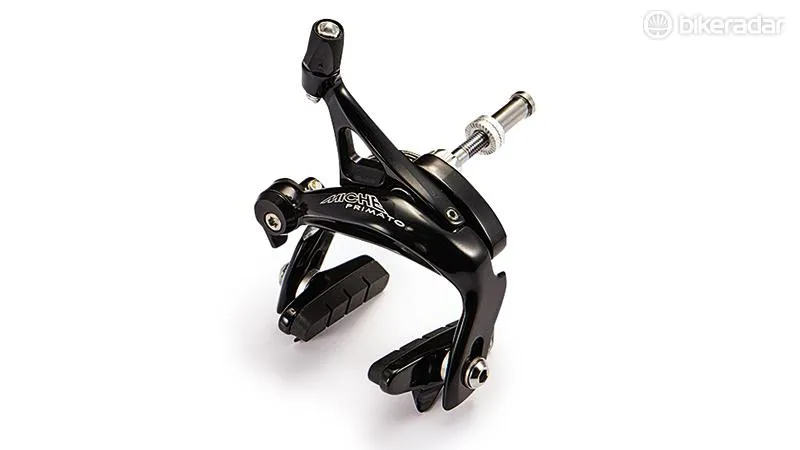
Primato caliper brakes from Miche are an excellent economy option
- Price: £30
- Weight: 164g
- Max rim width: 25mm
- Max rim drop: 49mm
Miche’s Primato brakes are an easily upgradeable economy option if you run conventional width rims. The QR cable clamp cam stops the pads opening more than 27mm in the closed position, but you can get another 2mm spread if you’re happy running the brakes ‘open’.
Otherwise, it’s a solid and communicative dual pivot design that doesn’t flinch at full strength pull. A powerful spring keeps potentially rattly levers quiet and there’s no notchiness or stiction in the action. The cartridge style holders make pad upgrading easy and it’s a decent weight despite the affordable price.
Verdict: If cost is your primary motivation when choosing a rim brake then Miche's Primatos are well worth a look
www.miche.it / Buy from Wiggle
Also tested
M5 Black Series RBC-150
- Price: £235
- Weight: 94g
- Max rim width: 26mm
- Max rim drop: 50mm
Verdict: These Low Countries caliper stoppers are high on power and precision, but are super expensive and width is limited
SRAM Red 22
- Price: £130 / US$142 / AU$250
- Weight: 127g
- Max rim width: 30mm
- Max rim drop: 50mm
Verdict: SRAM’s Red cable calipers minimise weight and drag without compromising control; they're not as powerful as the Shimano competition though
Read our full review of SRAM's Red 22 disc brakes
Avid BB7 Road
- Price: £TBC / US$86 / AU$100
- Weight: 331g
- Rotor: 160mm
- Cable-operated/mechanical
Verdict: Modulation isn’t as good as the Spyre, but tool-free pad adjusting dials and ball-bearing construction make the longstanding BB7 a worthy option
Hayes CX5 Expert
- Price: £44 / US$65 / €65
- Weight: 318g
- Rotor: 160mm
- Cable-operated/mechanical
Verdict: Bulky and requiring careful setup for optimum performance, these are nonetheless a strong budget disc choice with a solid action.
Read our full review of Hayes' CX5 Expert disc brakes
Final verdict
The more bikes we test with hydraulic discs, the more we don’t like going back to rim brakes. (Don’t get us wrong, Shimano’s SLR EV brakes have raised the game even at 105 level, and SRAM’s HydroR rim brakes deserve a lot more recognition for their incredible precision power.) The latest disc brake bikes we’ve ridden also prove that weight, responsiveness or ride quality don’t have to be compromised.
That makes the consistent control and increased power of disc brakes a game changer for most real-world recreational cyclists. TRP has done an amazing job of making that performance available through cable levers with its Spyre and Hy/Rd, and SRAM’s Red and Force are excellent if you want a lighter brake with a super-secure hand grip, but for ultimate heat-eating tech, unobtrusive lever design and performance for price, nothing beats Shimano’s R785/685 hydraulics.
A version of this article was originally published in Cycling Plus magazine, available on Apple Newsstand and Zinio.

